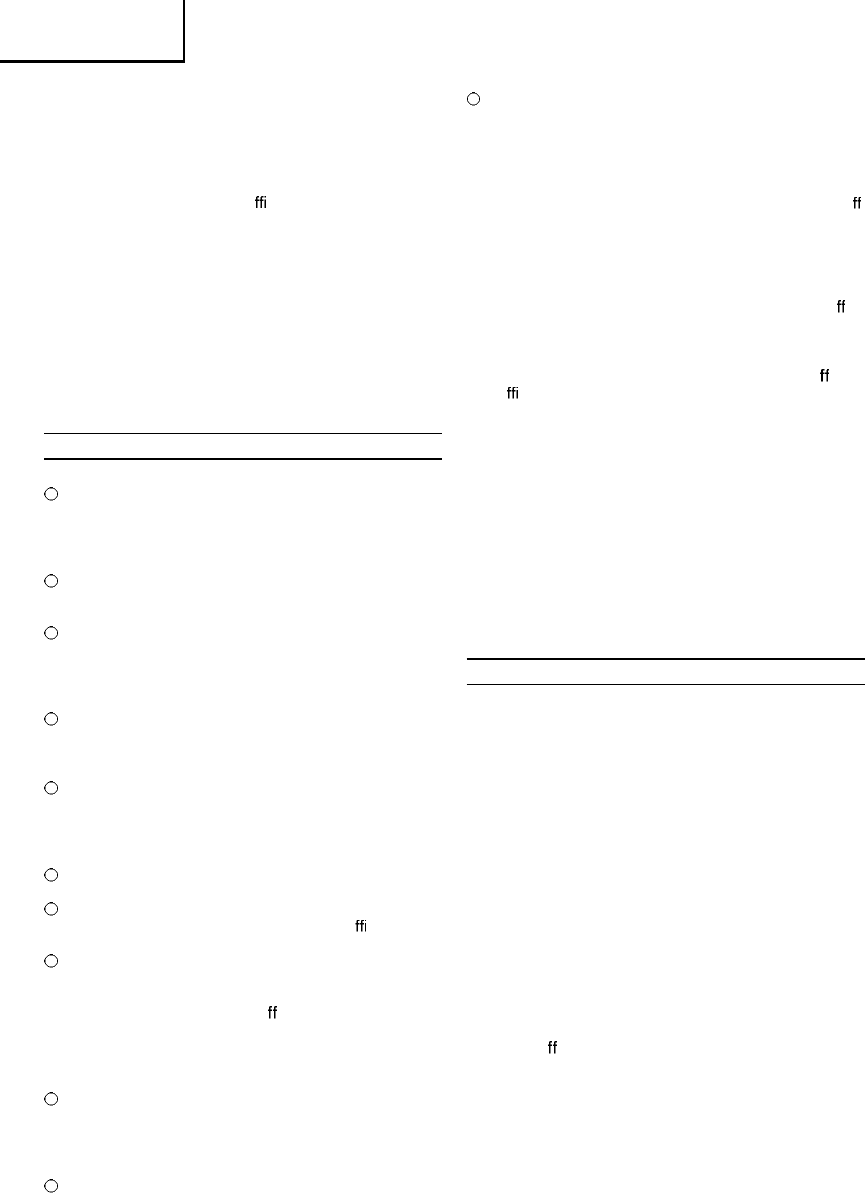
English
20
5. Check to make sure the water is fl owing out
(Fig. 17)
(1) Connect the trigger gun from which the nozzle has been
removed to the high-pressure hose.
(2) Plug in the power socket and set the switch to “ON”.
(3) Pull the trigger gun’s trigger, and then set the switch to
“OFF” after checking that su cient water is fl owing out.
6. Attach the nozzle.
NOTE
Set the switch at “OFF” if water does not fl ow out within
two minutes.
Failure to observe this may result in malfunctions (dry
operations.)
7. Washing
Set the switch at “ON” and pull the trigger gun’s trigger to
commence washing.
8. Cleaning
Remove all dirt from the strainer’s grill, wash it with water
and store it after it has dried.
WASHING
WARNING
Do not switch the washer on while the trigger is being
pulled.
Failure to observe this may result in high-pressure water
being sprayed immediately, leading to unexpected
accidents.
Do not point the nozzle at people or animals.
Failure to observe this may result in injury.
CAUTION
Set the switch to “OFF” immediately if the hose becomes
detached from the faucet or washer, and if water is no
longer being fed to the washer.
Failure to observe this may result in immediate
malfunctions (dry operations.)
Set the switch to “OFF” without fail when temporarily
suspending operations.
Failure to observe this may result in the motor
automatically starting up.
Place your fi nger in the center of the trigger during
operations (Fig. 18)
Failure to observe this may result in injury from pinched
fi ngers.
Grip the gun and nozzle fi rmly with both hands.
The trigger gun may kick back when water is discharged.
NOTE
Do not use the water hose when it is wound onto the reel.
Failure to observe this may result in insu cient water
feed.
Commence initial washing approximately 2 to 3 meters
away from the targeted item, and then move gradually
closer while checking the level of cleaning until you reach
a distance in which soiling is e ectively washed away.
The pressure of the spray from the washer is
approximately 20-times greater than tap water. High-
pressure water jets may therefore damage or peel the
coating from the items being washed.
There are cases when the water spray will appear
unstable owing to the fact that air that has built up in
the pump and hose is purged together with the water
immediately after use. In this event, allow the water to
fl ow out until it stabilizes.
Leave two or more seconds gap between pulling and
releasing the trigger.
Failure to observe this may result in the pressure switch
malfunctions.
Do not use the washer for more than thirty consecutive
minutes without giving it a break.
1. Open the faucet to its fullest.
Point the nozzle in a safe direction and then fully open the
faucet. Check to make sure no water is leaking from the
joints.
Release the trigger stopper with the washer switched o ,
pull the trigger on the trigger gun to discharge a small
amount of water from the nozzle with just the pressure
from the tap water. Check to make sure that no water is
leaking.
NOTE
Do not switch the washer on with the faucet turned o .
Failure to observe this may result in malfunctions.
2. Set the switch to the “ON” position (Fig. 19)
The motor will start operating when the washer is
switched on. The motor will automatically switch o once
su cient water pressure has built up inside the washer.
3. Pull the trigger (Fig. 20)
Hold the trigger gun fi rmly in both hands, point the nozzle
at the item to be washed, and then pull the trigger.
The high-pressure water jet will spray out.
Adjust the nozzle between “Jet” and “Spray” in
accordance with need.
Trigger stopper (Fig. 21)
The trigger gun is fi tted with a trigger stopper to prevent
the trigger from being pulled.
The trigger is locked and released by pressing the
stopper in the direction shown by the arrows.
NOTE
Lock the trigger with the trigger stopper during pauses
and after washing has been completed.
ON COMPLETION OF USE
Once the targeted item has been washed, drain the residual
water from the washer and store it in a well-ventilated
location to dry.
There are cases in which water left in the hose may freeze
during the winter, so drain as much water as possible and
store it indoors.
WARNING
Make sure all residual water is drained from the washer,
the trigger gun and the hose, etc., after use.
Failure to observe this may result in freezing, leading to
malfunctions.
1. Draining water from the washer
(1) Stop the water supply.
(2) Set the switch to “ON” and pull the trigger on the trigger
gun to drain the water from the inside of the washer.
Continue this until water is no longer discharged
(approximately 30 to 60 seconds.)
(3) Press the trigger stopper on the trigger gun to lock it in
place.
2. Set the switch to “OFF”.
(1) Switch o the washer.
(2) Unplug the power cord from the mains socket.
NOTE
Leaving the washer switched on may result in dry
operations, leading to malfunctions.
3. Removing the high-pressure hose (Fig. 22)
(1) Loosen the ring.
(2) Remove the high-pressure hose from the washer’s water
outlet.
(3) Drain all residual water from the high-pressure hose.


















